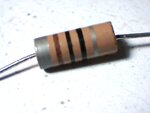lee321987
Member level 5

I bought some some components labeled as resistors from a surplus store.
I've attached a picture of one of them. It has flat ends (not rounded like most resistors I see). Also, the first band (silver) is much wider than all the other bands.
Is there any way to make sure this is a resistor and NOT an inductor?
The only test devices I have are two multimeters.
Also, am I right that all carbon film resistors have rounded ends, and all carbon composition resistors have flat ends?
I've attached a picture of one of them. It has flat ends (not rounded like most resistors I see). Also, the first band (silver) is much wider than all the other bands.
Is there any way to make sure this is a resistor and NOT an inductor?
The only test devices I have are two multimeters.
Also, am I right that all carbon film resistors have rounded ends, and all carbon composition resistors have flat ends?





